

Spring Security ACL - very basic tutorial. Introduction I spent last few days digging into Spring Security User Guide documentation.
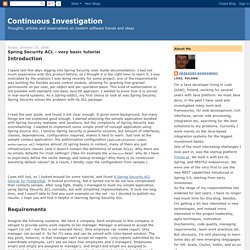
I had not much experience with this product before, so I thought it is the right time to learn it. I was motivated by the analysis I was doing recently for some project: one of the requirements was building the flexible access control module, allowing for granting fine-grained permissions on per-user, per-object and per-operation basis. This kind of authorization is not possible with standard role-base Java EE approach. I wanted to know how it is solved in real-world systems. I read the user guide, and found it not clear enough.
I was still lost, so I looked around for some tutorial, and found A Spring Security ACL tutorial for PostgreSQL. Requirements Imagine the following scenario. Implementation Domain model. Glen Mazza's Weblog : weblog. Spring Security 3 database schemas for MySQL - Spring in Practice. In preparation for a DZone Refcard on Spring Security 3 I’m doing, here are the Spring Security database schemas for MySQL.
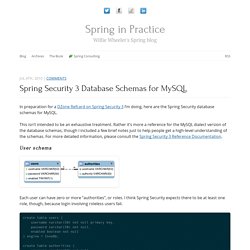
This isn’t intended to be an exhaustive treatment. Rather it’s more a reference for the MySQL dialect version of the database schemas, though I included a few brief notes just to help people get a high-level understanding of the schemas. For more detailed information, please consult the Spring Security 3 Reference Documentation. User schema Each user can have zero or more “authorities”, or roles. Create table users ( username varchar(50) not null primary key, password varchar(50) not null, enabled boolean not null ) engine = InnoDb; create table authorities ( username varchar(50) not null, authority varchar(50) not null, foreign key (username) references users (username), unique index authorities_idx_1 (username, authority) ) engine = InnoDb; Group schema The group schema provides a way to organize users into groups and then assign roles to those groups.
16. Domain Object Security (ACLs) Complex applications often will find the need to define access permissions not simply at a web request or method invocation level.
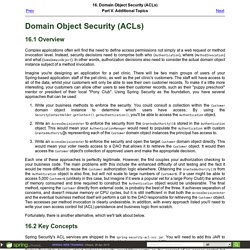
Instead, security decisions need to comprise both who (Authentication), where (MethodInvocation) and what (SomeDomainObject). In other words, authorization decisions also need to consider the actual domain object instance subject of a method invocation. Imagine you're designing an application for a pet clinic. There will be two main groups of users of your Spring-based application: staff of the pet clinic, as well as the pet clinic's customers. The staff will have access to all of the data, whilst your customers will only be able to see their own customer records.
Write your business methods to enforce the security. Each one of these approaches is perfectly legitimate. Fortunately, there is another alternative, which we'll talk about below. 'And' Spring @Secured Roles. Spring Security (previously Acegi) gives you an awesome AOP way of locking down methods in your Java application.

And well-placed lock down is a special power indeed. However, Spring disappoints a bit on this score because it turns out its default behavior is to ‘or’ the roles listed in @Secured annotation. You’d think the default would be the stricter ‘and’, but alas. But never fear, there is hope. Updated (21 June 2012): The easy way This article can be simplified into this line of code: There are other combo options as documented by Spring. If you wish to go on, enjoy the custom code and xml config that follows: :) There is always hope. Spring Security – adding a custom Role Prefix. When we work with Spring Security, more often we need to fit ourselves on pre-existent authorization environments.
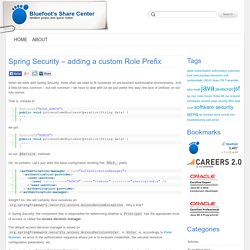
And a little bit less common – but still common – we have to deal with (or we just prefer this way) the lack of prefixes on our role names. That is, instead of we got: on our @Service methods. Ok, no problem. Allright? In Spring Security, the component that is responsible for determining whether a Principal has the appropriate level of access is called the access decision manager. The default access decision manager is based on org.springframework.security.access.AccessDecisionVoter. So, basically, the AccessDecisionManager passes to the Voters the access declaration of the resource being requested, and every vote will either ABSTAIN, DENY or GRANT access.
Securing a webservice at method level : Apache CXF + Spring Security + JSR-250 + wss4j « Diving deep into JEE. Continuous Investigation: Spring Security ACL - very basic tutorial. Spring Security – adding a custom Role Prefix. Allowing roles without defining them in intercept-url element. Spring Security Framework has lots of authentication and authorization features, and almost all of them can be customized and extended according to your own needs.
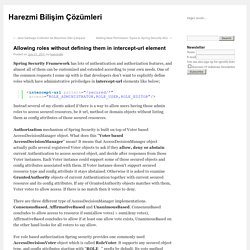
One of the common requests I come up with is that developers don’t want to explicitly define roles which have administrative priviledges in intercept-url elements like below; Instead several of my clients asked if there is a way to allow users having those admin roles to access secured resources, be it url, method or domain objects without listing them as config attributes of those secured resources. Authorization mechanism of Spring Security is built on top of Voter based AccessDecisionManager object.
What does this “Voter based AccessDecisionManager” mean? It means that AccessDecisionManager object actually polls several registered Voter objects to ask if they allow, deny or abstain current Authentication to access secured object, and decide after responses from those Voter instances. Let’s return back to our scenario now. 'And' Spring @Secured Roles - Jake Trent. Spring Security – adding a custom Role Prefix. Spring Security. Available as of Camel 2.3 The camel-spring-security component provides role-based authorization for Camel routes.
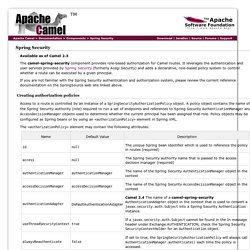
It leverages the authentication and user services provided by Spring Security (formerly Acegi Security) and adds a declarative, role-based policy system to control whether a route can be executed by a given principal. If you are not familiar with the Spring Security authentication and authorization system, please review the current reference documentation on the SpringSource web site linked above.
Creating authorization policies Access to a route is controlled by an instance of a SpringSecurityAuthorizationPolicy object. The <authorizationPolicy> element may contain the following attributes: